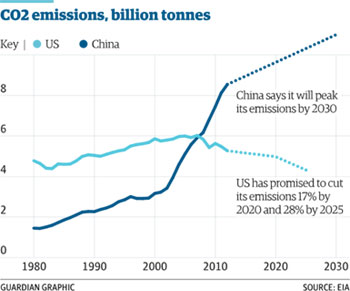Update October 1: Brazil added to its climate pledge. It will cut emissions 37% by 2025 from 2005 levels, and 43% by 2030.
During what’s usually a slow news week, the US, Brazil and China came forward with significant climate pledges.
As he did with China, President Obama and Brazil’s President Dilma Rousseff released a joint statement on climate change that says: both countries will get 20% of electricity from renewable energy by 2030 – and that does not include hydropower.
Further, by 2030, 28-33% of Brazil’s total energy will come from renewables and biofuels, and it will "improve low-carbon agricultural and grazing practices through sustainable agriculture," promote "clean technology standards for industry."
And Brazil also pledged to restore 12 million hectares (about 46,300 square miles) of forests by 2030 – an area roughly the size of England.
"Restoration at this scale combined with rapid and full implementation of existing laws would go a long way toward shifting Brazil from shrinking forests to expanding forests, with large benefits to the global climate as well as Brazil’s rural economy and local communities," Michael Wolosin at Climate Advisers, told the Washington Post.
"We want to reach zero deforestation by 2030 in Brazil, zero illegal deforestation by 2030," Rousseff says. Unfortunately, after falling significantly for five years, deforestation is rising sharply again and destructive mega-dams being built in the Amazon will make her goals harder to achieve. And to her, reforestation could include palm oil plantations, which certainly don’t qualify as forest.
One way Brazil plans to restore forests is to require all 5 million landowners to register by May 2016, putting the onus on agribusinesses to show they are maintaining 80% native forest cover – as required by law. If they don’t register by 2017, they won’t be eligible for bank loans, reports RTCC. If they fess up, they must restore forests over 20 years.
A combination of satellites, radar and helicopter patrols pick up illegal forest clearing. Once they spot illegal logging, police follow-up on the ground within two days. It is a battle of wits, as criminals use camouflaged equipment, take advantage of cloud cover and cut only small areas to avoid detection, Francisco Oliveira, a top official at Brazil’s environment ministry, told RTCC.
18.5% of Brazil’s Amazon is gone and 20% of that is recovering, according to RTCC. The loss is already causing significant changes in precipitation, and Brazil is in the midst of severe drought.
Obama and Rousseff are launching a Joint Initiative on Climate Change this year – a high-level working group to cooperate on climate issues such as clean energy, land use and adaptation. They agreed to bring down the use of HFCs.
"Brazil and the United States commit to new and improved management of their forests, croplands and grasslands to increase resilience in forests and agricultural systems, safeguard the multiple services they provide, and share this expertise with other countries," says their statement. They list many important actions, such as attracting investments in sustainable forest management and forest restoration.
China’s Pledge
China added to the pledge made in concert with the US, where it agreed to peak carbon emissions by 2030 (and will work hard to get there sooner), and to reach 20% clean energy through renewables and nuclear by then.

In its formal submission to the United Nations, China says it will cut carbon intensity (per unit of GDP) 40-45% below 2005 levels by 2020 and 60-65% by 2030.
Goals submitted to the UN are 200 gigawatts (GW) of wind and 100 GW of solar (from 116 GW and 28 GW now). It expects 10% of energy from natural gas by 2020 as it gets into fracking.
China also promises to "vigorously enhance afforestation," increasing carbon stored in forests by 4.5 billion cubic meters by then.
While some experts say these targets are too weak, they applaud China’s attention to reducing other greenhouse gases by eliminating HFCs and HCFCs.
South Korea, New Zealand Submit UN Pledges
South Korea pledges to cut emissions 37% by 2030 from current levels and New Zealand commits to 30% below 2005 levels by then – both are viewed as fairly weak.
Europe Gets Serious
Miguel Cañete, the EU’s climate negotiator, told The Guardian, that he’s "85% confident" that a historic deal will be struck this year in Paris, but if it doesn’t happen, there’s no plan B. If the 196 countries don’t reach consensus on an international climate agreement, there will be no ongoing UN discussions. "Paris is final."
And the EU will not vote for a deal that isn’t ambitious enough to deal with the problem. "For us, it’s very important to have a deal – but not any kind of deal." He’s traveling around the world, visiting with countries to garner support for a strong agreement right now.
In what will clearly be a problem for the US – with Republicans staunchly still denying the existence of climate change – the EU wants a legally binding global deal, enforced through 5-year reviews to ensure the world is on track for the 2C mark.
In October, the EU will hold an event in Morocco, where it will count all country’s pledges to see whether they meet the target. Right now, they are off by about 1C.
If you haven’t read the US submission, Read our article, US Officially Submits Climate Targets to United Nations.
Read the joint statement from the US and Brazil:
